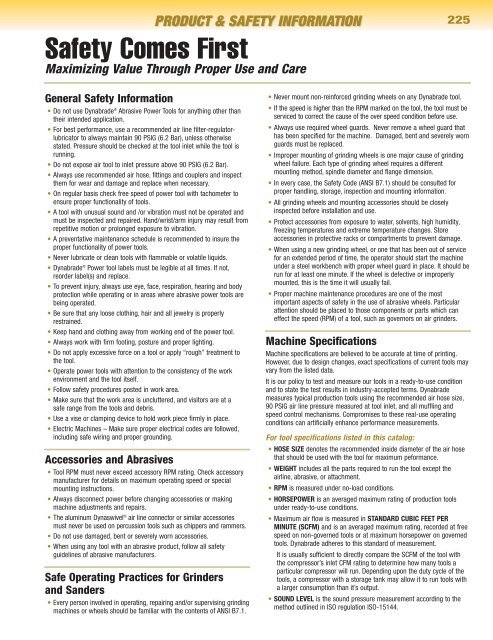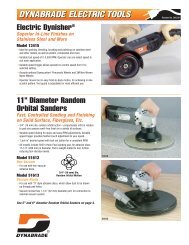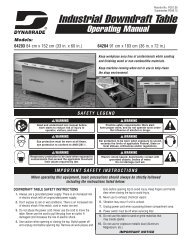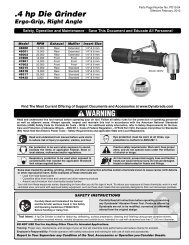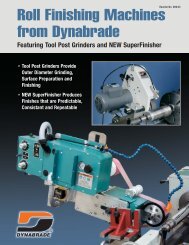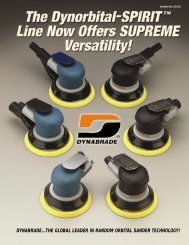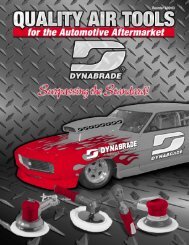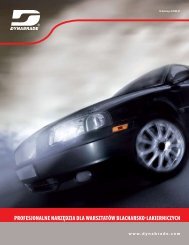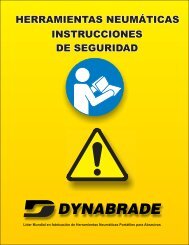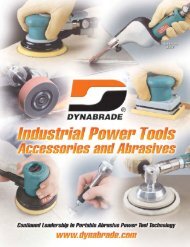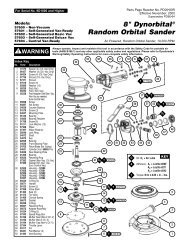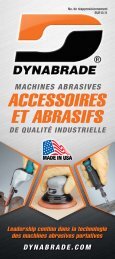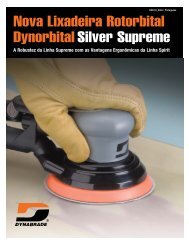abrasive belt tools
abrasive belt tools
abrasive belt tools
- No tags were found...
Create successful ePaper yourself
Turn your PDF publications into a flip-book with our unique Google optimized e-Paper software.
PRODUCT & SAFETY INFORMATIONSafety Comes FirstMaximizing Value Through Proper Use and Care225General Safety Information• Do not use Dynabrade ® Abrasive Power Tools for anything other thantheir intended application.• For best performance, use a recommended air line filter-regulatorlubricatorto always maintain 90 PSIG (6.2 Bar), unless otherwisestated. Pressure should be checked at the tool inlet while the tool isrunning.• Do not expose air tool to inlet pressure above 90 PSIG (6.2 Bar).• Always use recommended air hose, fittings and couplers and inspectthem for wear and damage and replace when necessary.• On regular basis check free speed of power tool with tachometer toensure proper functionality of <strong>tools</strong>.• A tool with unusual sound and /or vibration must not be operated andmust be inspected and repaired. Hand/wrist/arm injury may result fromrepetitive motion or prolonged exposure to vibration.• A preventative maintenance schedule is recommended to insure theproper functionality of power <strong>tools</strong>.• Never lubricate or clean <strong>tools</strong> with flammable or volatile liquids.• Dynabrade ® Power tool labels must be legible at all times. If not,reorder label(s) and replace.• To prevent injury, always use eye, face, respiration, hearing and bodyprotection while operating or in areas where <strong>abrasive</strong> power <strong>tools</strong> arebeing operated.• Be sure that any loose clothing, hair and all jewelry is properlyrestrained.• Keep hand and clothing away from working end of the power tool.• Always work with firm footing, posture and proper lighting.• Do not apply excessive force on a tool or apply “rough” treatment tothe tool.• Operate power <strong>tools</strong> with attention to the consistency of the workenvironment and the tool itself.• Follow safety procedures posted in work area.• Make sure that the work area is uncluttered, and visitors are at asafe range from the <strong>tools</strong> and debris.• Use a vise or clamping device to hold work piece firmly in place.• Electric Machines – Make sure proper electrical codes are followed,including safe wiring and proper grounding.Accessories and Abrasives• Tool RPM must never exceed accessory RPM rating. Check accessorymanufacturer for details on maximum operating speed or specialmounting instructions.• Always disconnect power before changing accessories or makingmachine adjustments and repairs.• The aluminum Dynaswivel ® air line connector or similar accessoriesmust never be used on percussion <strong>tools</strong> such as chippers and rammers.• Do not use damaged, bent or severely worn accessories.• When using any tool with an <strong>abrasive</strong> product, follow all safetyguidelines of <strong>abrasive</strong> manufacturers.Safe Operating Practices for Grindersand Sanders• Every person involved in operating, repairing and/or supervising grindingmachines or wheels should be familiar with the contents of ANSI B7.1.• Never mount non-reinforced grinding wheels on any Dynabrade tool.• If the speed is higher than the RPM marked on the tool, the tool must beserviced to correct the cause of the over speed condition before use.• Always use required wheel guards. Never remove a wheel guard thathas been specified for the machine. Damaged, bent and severely wornguards must be replaced.• Improper mounting of grinding wheels is one major cause of grindingwheel failure. Each type of grinding wheel requires a differentmounting method, spindle diameter and flange dimension.• In every case, the Safety Code (ANSI B7.1) should be consulted forproper handling, storage, inspection and mounting information.• All grinding wheels and mounting accessories should be closelyinspected before installation and use.• Protect accessories from exposure to water, solvents, high humidity,freezing temperatures and extreme temperature changes. Storeaccessories in protective racks or compartments to prevent damage.• When using a new grinding wheel, or one that has been out of servicefor an extended period of time, the operator should start the machineunder a steel workbench with proper wheel guard in place. It should berun for at least one minute. If the wheel is defective or improperlymounted, this is the time it will usually fail.• Proper machine maintenance procedures are one of the mostimportant aspects of safety in the use of <strong>abrasive</strong> wheels. Particularattention should be placed to those components or parts which caneffect the speed (RPM) of a tool, such as governors on air grinders.Machine SpecificationsMachine specifications are believed to be accurate at time of printing.However, due to design changes, exact specifications of current <strong>tools</strong> mayvary from the listed data.It is our policy to test and measure our <strong>tools</strong> in a ready-to-use conditionand to state the test results in industry-accepted terms. Dynabrademeasures typical production <strong>tools</strong> using the recommended air hose size,90 PSIG air line pressure measured at tool inlet, and all muffling andspeed control mechanisms. Compromises to these real-use operatingconditions can artificially enhance performance measurements.For tool specifications listed in this catalog:• HOSE SIZE denotes the recommended inside diameter of the air hosethat should be used with the tool for maximum peformance.• WEIGHT includes all the parts required to run the tool except theairline, <strong>abrasive</strong>, or attachment.• RPM is measured under no-load conditions.• HORSEPOWER is an averaged maximum rating of production <strong>tools</strong>under ready-to-use conditions.• Maximum air flow is measured in STANDARD CUBIC FEET PERMINUTE (SCFM) and is an averaged maximum rating, recorded at freespeed on non-governed <strong>tools</strong> or at maximum horsepower on governed<strong>tools</strong>. Dynabrade adheres to this standard of measurement.It is usually sufficient to directly compare the SCFM of the tool withthe compressor’s inlet CFM rating to determine how many <strong>tools</strong> aparticular compressor will run. Depending upon the duty cycle of the<strong>tools</strong>, a compressor with a storage tank may allow it to run <strong>tools</strong> witha larger consumption than it’s output.• SOUND LEVEL is the sound pressure measurement according to themethod outlined in ISO regulation ISO-15144.


